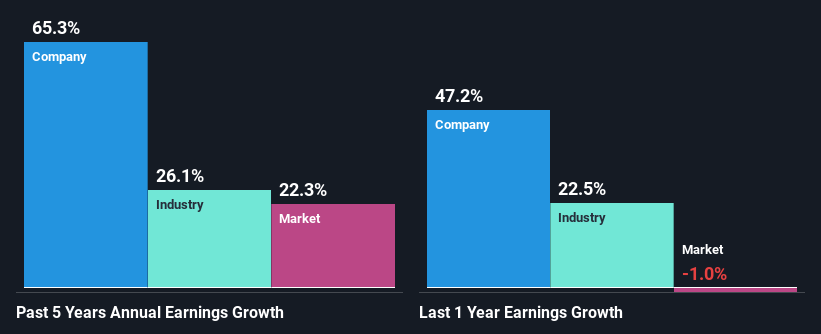Declining Stock and Solid Fundamentals: Is The Market Wrong About Kepler Weber S.A. (BVMF:KEPL3)?
Kepler Weber (BVMF:KEPL3) has had a rough three months with its share price down 38%. However, stock prices are usually driven by a company’s financial performance over the long term, which in this case looks quite promising. Particularly, we will be paying attention to Kepler Weber's ROE today.
ROE or return on equity is a useful tool to assess how effectively a company can generate returns on the investment it received from its shareholders. In other words, it is a profitability ratio which measures the rate of return on the capital provided by the company's shareholders.
View our latest analysis for Kepler Weber
How Do You Calculate Return On Equity?
The formula for return on equity is:
Return on Equity = Net Profit (from continuing operations) ÷ Shareholders' Equity
So, based on the above formula, the ROE for Kepler Weber is:
52% = R$340m ÷ R$651m (Based on the trailing twelve months to March 2023).
The 'return' is the income the business earned over the last year. That means that for every R$1 worth of shareholders' equity, the company generated R$0.52 in profit.
Why Is ROE Important For Earnings Growth?
We have already established that ROE serves as an efficient profit-generating gauge for a company's future earnings. We now need to evaluate how much profit the company reinvests or "retains" for future growth which then gives us an idea about the growth potential of the company. Generally speaking, other things being equal, firms with a high return on equity and profit retention, have a higher growth rate than firms that don’t share these attributes.
Kepler Weber's Earnings Growth And 52% ROE
To begin with, Kepler Weber has a pretty high ROE which is interesting. Secondly, even when compared to the industry average of 20% the company's ROE is quite impressive. So, the substantial 65% net income growth seen by Kepler Weber over the past five years isn't overly surprising.
Next, on comparing with the industry net income growth, we found that Kepler Weber's growth is quite high when compared to the industry average growth of 26% in the same period, which is great to see.

Earnings growth is an important metric to consider when valuing a stock. The investor should try to establish if the expected growth or decline in earnings, whichever the case may be, is priced in. By doing so, they will have an idea if the stock is headed into clear blue waters or if swampy waters await. One good indicator of expected earnings growth is the P/E ratio which determines the price the market is willing to pay for a stock based on its earnings prospects. So, you may want to check if Kepler Weber is trading on a high P/E or a low P/E, relative to its industry.
Is Kepler Weber Efficiently Re-investing Its Profits?
The three-year median payout ratio for Kepler Weber is 29%, which is moderately low. The company is retaining the remaining 71%. By the looks of it, the dividend is well covered and Kepler Weber is reinvesting its profits efficiently as evidenced by its exceptional growth which we discussed above.
Besides, Kepler Weber has been paying dividends for at least ten years or more. This shows that the company is committed to sharing profits with its shareholders.
Summary
On the whole, we feel that Kepler Weber's performance has been quite good. Specifically, we like that the company is reinvesting a huge chunk of its profits at a high rate of return. This of course has caused the company to see substantial growth in its earnings. If the company continues to grow its earnings the way it has, that could have a positive impact on its share price given how earnings per share influence long-term share prices. Remember, the price of a stock is also dependent on the perceived risk. Therefore investors must keep themselves informed about the risks involved before investing in any company. You can see the 1 risk we have identified for Kepler Weber by visiting our risks dashboard for free on our platform here.
Valuation is complex, but we're here to simplify it.
Discover if Kepler Weber might be undervalued or overvalued with our detailed analysis, featuring fair value estimates, potential risks, dividends, insider trades, and its financial condition.
Access Free AnalysisHave feedback on this article? Concerned about the content? Get in touch with us directly. Alternatively, email editorial-team (at) simplywallst.com.
This article by Simply Wall St is general in nature. We provide commentary based on historical data and analyst forecasts only using an unbiased methodology and our articles are not intended to be financial advice. It does not constitute a recommendation to buy or sell any stock, and does not take account of your objectives, or your financial situation. We aim to bring you long-term focused analysis driven by fundamental data. Note that our analysis may not factor in the latest price-sensitive company announcements or qualitative material. Simply Wall St has no position in any stocks mentioned.
About BOVESPA:KEPL3
Kepler Weber
Provides grain storage equipment and post-harvest grain solutions in Brazil, the Americas, Africa, Europe, and Asia.
Excellent balance sheet with reasonable growth potential.
Similar Companies
Market Insights
Community Narratives



